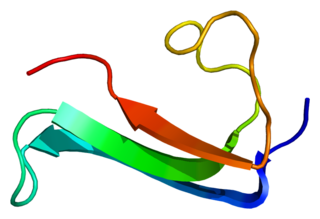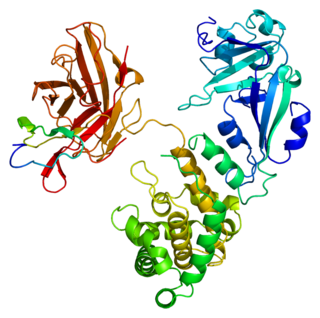
Midkine, also known as neurite growth-promoting factor 2 (NEGF2), is a protein that in humans is encoded by the MDK gene.

Heparin-binding EGF-like growth factor (HB-EGF) is a member of the EGF family of proteins that in humans is encoded by the HBEGF gene.

Insulin-like growth factor-binding protein 5(IBF-5) is a protein that in humans is encoded by the IGFBP5 gene. An IGFBP5 gene was recently identified as being important for adaptation to varying water salinity in fish.

Syndecan-2 is a protein that in humans is encoded by the SDC2 gene.

Syndecan-4 is a protein that in humans is encoded by the SDC4 gene. Syndecan-4 is one of the four vertebrate syndecans and has a molecular weight of ~20 kDa. Syndecans are the best-characterized plasma membrane proteoglycans. Their intracellular domain of membrane-spanning core protein interacts with actin cytoskeleton and signaling molecules in the cell cortex. Syndecans are normally found on the cell surface of fibroblasts and epithelial cells. Syndecans interact with fibronectin on the cell surface, cytoskeletal and signaling proteins inside the cell to modulate the function of integrin in cell-matrix adhesion. Also, syndecans bind to FGFs and bring them to the FGF receptor on the same cell. As a co-receptor or regulator, mutated certain proteoglycans could cause severe developmental defects, like disordered distribution or inactivation of signaling molecules.

Nuclear respiratory factor 1, also known as Nrf1, Nrf-1, NRF1 and NRF-1, encodes a protein that homodimerizes and functions as a transcription factor which activates the expression of some key metabolic genes regulating cellular growth and nuclear genes required for respiration, heme biosynthesis, and mitochondrial DNA transcription and replication. The protein has also been associated with the regulation of neurite outgrowth. Alternate transcriptional splice variants, which encode the same protein, have been characterized. Additional variants encoding different protein isoforms have been described but they have not been fully characterized. Confusion has occurred in bibliographic databases due to the shared symbol of NRF1 for this gene and for "nuclear factor -like 1" which has an official symbol of NFE2L1.

Syntenin-1 is a protein that in humans is encoded by the SDCBP gene.

Insulin-like growth factor-binding protein 1 (IBP-1) also known as placental protein 12 (PP12) is a protein that in humans is encoded by the IGFBP1 gene.

Ribosomal protein S6 kinase alpha-2 is an enzyme that in humans is encoded by the RPS6KA2 gene.

Syndecan-3 is a protein that in humans is encoded by the SDC3 gene.

Disintegrin and metalloproteinase domain-containing protein 9 is an enzyme that in humans is encoded by the ADAM9 gene.

Receptor-type tyrosine-protein phosphatase mu is an enzyme that in humans is encoded by the PTPRM gene.

Sterile alpha motif and leucine zipper containing kinase AZK, also known as ZAK, is a human gene.

Fibroblast growth factor-binding protein 1 is a protein that in humans is encoded by the FGFBP1 gene.

Nardilysin is a protein that in humans is encoded by the NRD1 gene.

Fasciculation and elongation protein zeta-1 is a protein that in humans is encoded by the FEZ1 gene.

Neurocan core protein is a protein that in humans is encoded by the NCAN gene.

Thrombospondin-4 is a protein that in humans is encoded by the THBS4 gene.

Rho GTPase-activating protein 32 is a protein that in humans is encoded by the RICS gene. RICS has two known isoforms, RICS that are expressed primarily at neurite growth cones, and at the post synaptic membranes, and PX-RICS which is more widely expressed in the endoplasmic reticulum, Golgi apparatus and endosomes. The only known domain of the RICS is the RhoGAP domain, whilst PX-RICS has an additional Phox homology and SH3 domain.

Rap guanine nucleotide exchange factor 2 is a protein that in humans is encoded by the RAPGEF2 gene.






















